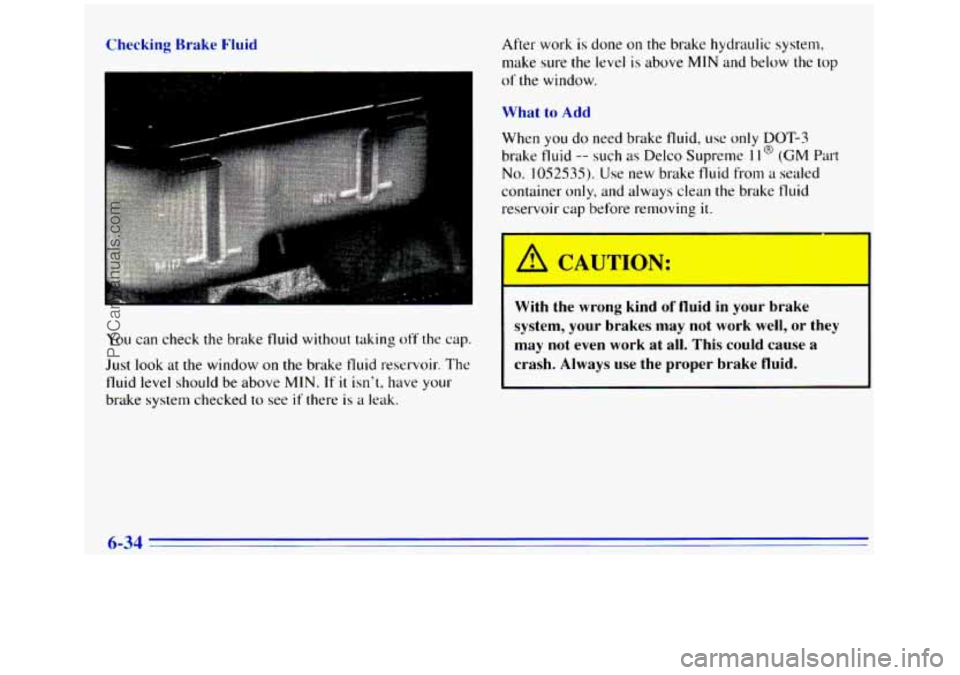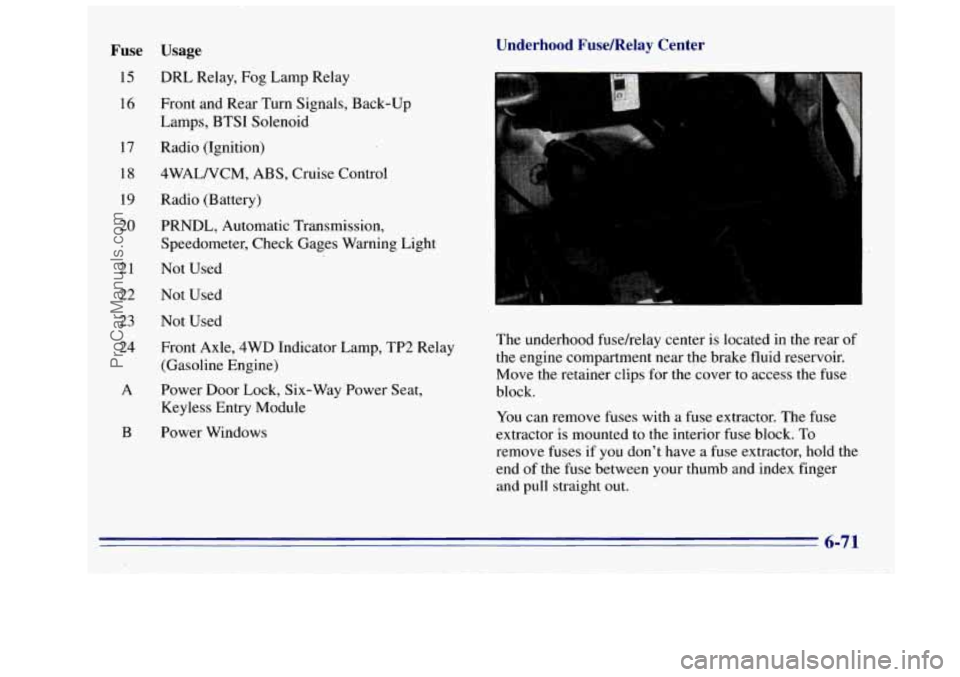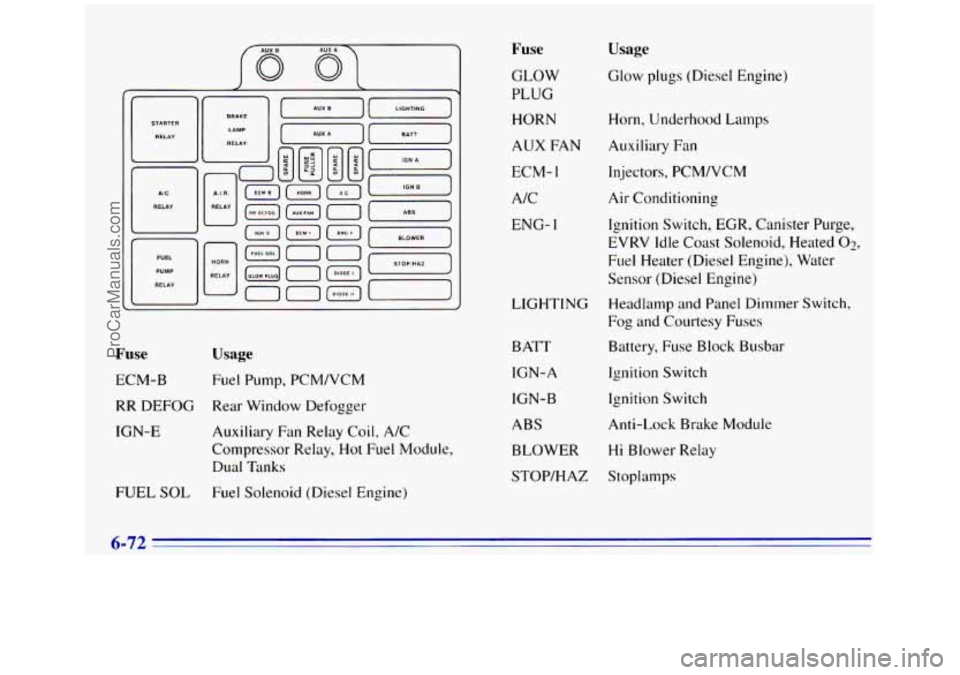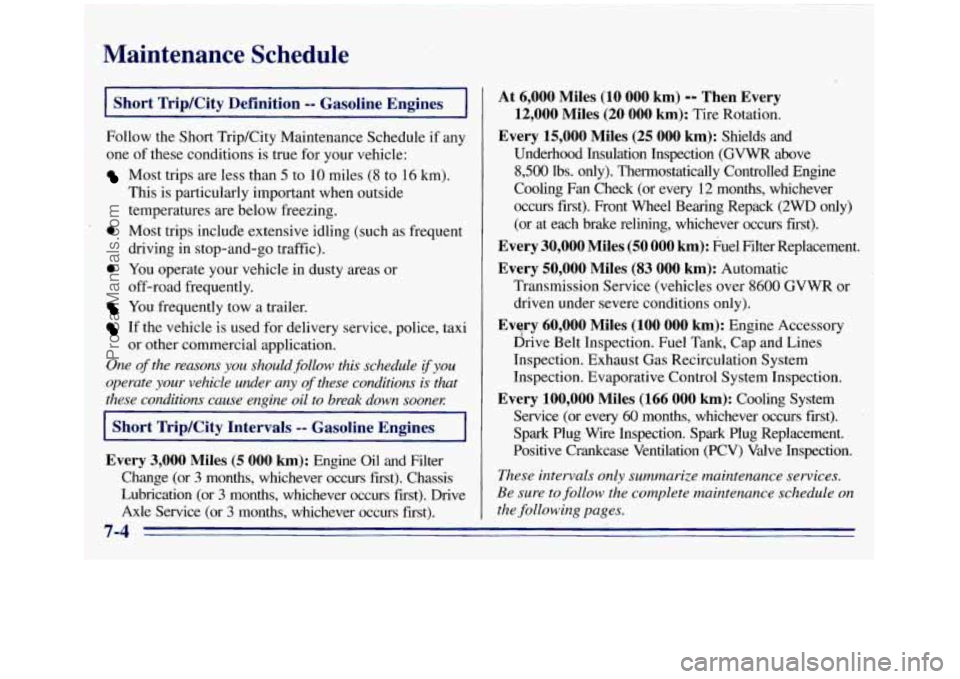1996 GMC SIERRA brake
[x] Cancel search: brakePage 284 of 404

Checking Brake 1
You can check the brake fluid without taking off the cap.
Just look at
the window on the brake fluid reservoir. The
fluid level should be above MIN. If it isn't, have your
brake system checked to see if there is a leak. After
work
is done on the brake hydraulic system,
make sure the level is above
MIN and below the top
of the window.
What to 1
When you do need brake fluid, use only DOT-3
brake fluid -- such as Delco Supreme 11 @ (GM Part
No. 1052535). Use new brake fluid from a sealed
container
only, and always clean the brake fluid
reservoir cap before removing
it.
I I
I A CAUTION: I
With the wrong kind of fluid in your brake
system, your brakes may not work well, or they
may not even work at
all. This could cause a
crash. Always use the proper brake fluid.
6-34
ProCarManuals.com
Page 285 of 404

NOTICE:
0
0
Using the wrong fluid can badly damage
brake system parts. For example,.just a few
drops of mineral-based oil, such
as engine
oil,
in your brake system can damage brake
system parts
so badly that they’ll have to be
replaced. Don’t let someone put in the
wrong kind of fluid.
If you spill brake fluid on your vehicle’s
painted surfaces, the paint finish can be
damaged. Be careful not to spill brake
fluid on your vehicle.
If you do, wash it
off immediately. See &‘Appearance Care”
in
the Index.
Brake Wear
If you have a C 3500 HD model, it has four-wheel
disc brakes.
Disc brake pads have built-in wear indicators that
make a high-pitched warning sound when the brake
pads are worn and
new pads are needed. The sound
may come and
go or be heard all the time your vehicle
is moving (except when you are pushing on the brake
pedal firmly).
A’ CAUTION:
I
The brake wear warning sound means that
sooner or later your brakes won’t work well.
That could lead to an accident. When you hear
the brake wear warning sound, have your vehicle serviced.
6-35
ProCarManuals.com
Page 286 of 404

NOTICE: .
Continuing to drive with worn-out brake pads
could result in costly brake repair.
Some driving conditions or climates may cause a brake
squeal when the brakes are first applied or lightly
applied. This does not mean something is wrong with
your brakes.
Free movement
of brake calipers and properly torqued
wheel nuts
are necessary to help prevent brake
pulsation. When tires
are rotated, inspect.brake calipers
for movement, brake pads for wear, and evenly torque
wheel nuts in the proper sequence
to GM specifications.
If you have rear drum brakes, they don’t have wear
indicators, but
if you ever hear a rear brake rubbing
noise, have the rear brake linings inspected.
Also, the
rear brake drums should be remoQed and inspected each
time the tires are removed for rotation or changing.
When you have the front brakes replaced, have the rear
brakes inspected,
too. I
Brake linings should always be replaced as complete
axle sets.
Brake Pedal Travel
See your dealer if the brake pedal does not return to
normal height, or if there is a rapid increase in pedal
travel. This could be a sign of brake trouble.
Brake Adjustment
Every time you make a brake stop, your disc brakes
adjust for wear.
If your brake pedal goes down farther than normal, your
rear drum brakes may need adjustment. Adjust them by
backing up and firmly applying the brakes a few times.
Replacing Brake System Parts
The braking system on a modern vehicle is complex. Its
many parts have to be
of top quality and work well
together if the vehicle is to have really good braking.
Vehicles we design and test have top-quality
GM brake
parts
in them, as your vehicle does when it is new. When
you replace parts of your braking system -- for example,
when- your brhke linings wear do.wn and you have
to
haye new ones put in -- be sure you get new genuine
GM replacement parts. If you don’t, your brakes may
no longer work properly. For example,
if someone
puts in brake linings that are wrong for your vehicle,
the balance between your front and rear brakes can
change
-- for the worse. The braking performance
you’ve come to expect can change
in many other ways
if someone puts in the wrong replacement brake parts.
I
I
6-36
ProCarManuals.com
Page 306 of 404

Each new wheel should have the same load-carrying
capacity, diameter, width, offset and be mounted the same way as the one it replaces.
If you need to replace any
of your wheels, wheel bolts
or wheel nuts, replace them only with new
GM original
equipment parts. This way, you will be sure
to have the
right wheel, wheel bolts and wheel nuts for your vehicle.
CAUTION:
I
Using the wrong replacement wheels, wheel bolts
or wheel nuts on your vehicle can be dangerous.
It could affect the braking and handling of your
vehicle, make your tires lose air and make you
lose. control.
You could have a collision in which
you or others could be injured. Always use the
correct wheel, wheel bolts and wheel nuts for
replacement.
NOTICE:
The wrong wheel can also cause problems with
bearing life, brake cooling, speedometer or
odometer calibration, headlamp aim, bumper
height, vehicle ground clearance and tire or tire
chain clearance to the body and chassis.
7
Whenever a wheel, wheel bolt or wheel nut is replaced
on a dual wheel setup, check the wheel
nut torque after
100,
1,000 and 6,000 miles (160, 1 600 and 10 000 km)
of driving. For proper torque, see “Wheel Nut Torque”
in
the Index.
See “Changing a Flat Tire” in the Index for
more information.
6-56
ProCarManuals.com
Page 321 of 404

Fuse Usage
15 DRL Relay, Fog Lamp Relay
Underhood Fusemelay Center
16
17
18
19
20
21
22
23 24 Front and Rear Turn
Signals, Back-up
Lamps, BTSI Solenoid
Radio (Ignition)
4WALNCM, ABS, Cruise Control
Radio (Battery)
PRNDL, Automatic Transmission,
Speedometer, Check Gages Warning Light
Not Used
Not Used
Not Used
Front Axle, 4WD Indicator Lamp, TP2 Relay
(Gasoline Engine)
A Power Door Lock, Six-Way Power Seat,
Keyless Entry Module
B Power Windows The underhood
fusehelay center is located in the rear
of
the engine compartment near the brake fluid reservoir.
Move the retainer clips for the cover to access the fuse
block.
You can remove fuses with a fuse extractor. The fuse
extractor
is mounted to the interior fuse block. To
remove fuses if
you don’t have a fuse extractor, hold the
end of the fuse between your thumb and index finger
and
pull straight out.
6-71
ProCarManuals.com
Page 322 of 404

Fuse
ECM-B
Usage
Fuel Pump, PCM/VCM
RR DEFOG Rear Window Defogger
IGN-E Auxiliary Fan Relay Coil, A/C
Compressor Relay, Hot Fuel Module,
Dual Tanks
FUEL SOL Fuel Solenoid (Diesel Engine)
Fuse
GLOW
PLUG
HORN
AUX FAN
ECM-
1
A/C
ENG-
1
Usage
Glow plugs (Diesel Engine)
Horn, Underhood Lamps Auxiliary Fan
Injectors, PCM/VCM
Air Conditioning
Ignition Switch, EGR, Canister Purge,
EVRV Idle Coast Solenoid, Heated
02,
Fuel Heater (Diesel Engine), Water
Sensor (Diesel Engine)
LIGHTING Headlamp and Panel Dimmer Switch,
Fog and Courtesy Fuses
Battery,
Fuse Block Busbar
BATT
IGN-A
IGN-B
ABS Ignition Switch
Ignition Switch
Anti-Lock Brake Module
BLOWER
Hi Blower Relay
STOP/HAZ Stoplamps
ProCarManuals.com
Page 330 of 404

Maintenance Schedule
I Short Trip/City Definition -- Gasoline Engines . I ~
Follow the Short Trip/City Maintenance Schedule if any
one of these conditions is true for your vehicle:
Most trips are less than 5 to 10 miles (8 to 16 km).
This is particularly important when outside
temperatures are below freezing.
driving in stop-and-go traffic).
off-road frequently.
0 Most trips include extensive idling (such as frequent
0 You operate your vehicle in dusty areas or
You frequently tow a trailer.
If the vehicle is used for delivery service, police, taxi
One of the reasons you should follow this schedule if you
operate your vehicle under any of these conditions is that
these conditions cause engine oil to break down soonez
or other commercial application.
I Short Trip/City Intervals -- Gasoline Engines I
Every 3,000 Miles (5 000 km): Engine Oil and Filter
Change
(or 3 months, whichever occurs first). Chassis
Lubrication (or
3 months, whichever occurs first). Drive
Axle Service (or
3 months, whichever occurs first).
At 6,000 Miles (10 000 km) -- Then Every
12,000 Miles (20
000 km): 'Tire Rotation.
Every 15,000 Miles (25 000 km): Shields and
Underhood Insulation Inspection
(GVWR above
8,500 lbs. only). Thermostatically Controlled Engine
Cooling Fan Check (or every
12 months, whichever
occurs first). Front Wheel Bearing Repack
(2WD only)
(or at each brake relining, whichever occurs first).
Every 30,000 Miles (50 000 km): Fuel Filter Replacement.
Every 50,000 Miles (83 000 km): Automatic
Transmission Service (vehicles over
8600 GVWR or
driven under severe conditions only).
Evwy 60,000 Miles (100 000 km): Engine Accessory
Drive Belt Inspection. Fuel Tank, Cap and Lines
Inspection. Exhaust Gas Recirculation System
Inspection. Evaporative Control System Inspection.
Every 100,000 Miles (166 000 km): Cooling System
Service (or every
60 months, whichever occurs first).
Spark Plug Wire Inspection. Spark Plug Replacement.
Positive Crankcase Ventilation
(PCV) Valve Inspection.
These intervals only summarize maintenance services.
Be sure to follow the complete maintenance schedule
on
the following pages.
7-4
ProCarManuals.com
Page 331 of 404

Maintenance Schedule
Long Trip/Highway Definition -- Gasoline Engines 1
Follow this maintenance schedule only if none of the
conditions from the Short TripKity Maintenance
Schedule is true.
Driving a vehicle with a fully warmed engine
under highway conditions causes engine oil to break
down slower:
I Long Tripmighway Intervals -- Gasoline Engines I
Every 7,500 Miles (12 500 km): Engine Oil and Filter
Change (or every
12 months, whichever occurs first).
Chassis Lubrication (or every
12 months, whichever
occurs first). Drive Axle Service.
At 7,500 Miles (12 500 km) -- Then Every
15,000 Miles (25
000 km): Tire Rotation.
Every 15,000 Miles (25 000 km): Shields and
Underhood Insulation Inspection (GVWR above
8,500 lbs. only). Thermostatically Controlled Engine
Cooling Fan Check (or every
12 months, whichever
occurs first).
Every 30,000 Miles (50 000 km): Fuel Filter
Replacement. Front Wheel Bearing Repack
(2WD only) (or at each brake relining, whichever
occurs first).
Transmission Service (vehicles over
8600 GVWR or
driven under severe conditions only).
-Every 60,000 Miles (100 000 km): Engine Accessory I
Drive Belt Inspection. Fuel Tank, Cap and Lines
Inspection. Exhaust Gas Recirculation System
Inspection. Evaporative Control System Inspection.
Every 100,000 Miles (166 000 km): Cooling System
Service (or every
60 months, whichever occurs first).
Spark Plug Wire Inspection. Spark Plug Replacement.
Positive Crankcase Ventilation (PCV) Valve Inspection.
These intervals only summarize maintenance services.
Be sure to follow the complete maintenance schedule
on the following pages.
Every 50,000 Miles (83 000 km): Automatic
7-5
ProCarManuals.com